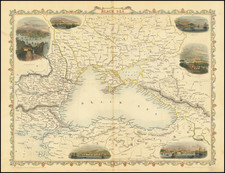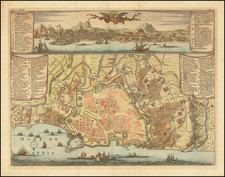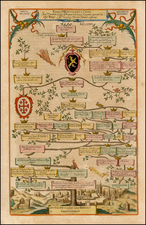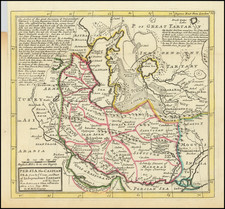Rare early 2 sheet separately issued set of 6 maps, showing Jerusalem, the Holy Land, the travels of the Apostles, the location of the children of Noah, Paridise and the land of Canaan, "Printed for Robt. Sayer Map and Printseller of the Golden Buck in Fleet Street."
The map is an interesting and evidently hurried compilation of 6 maps, with extra engraved titles, borders and text. In several areas, the lines above and below the text strongly suggest that this was a proof state. It would seem that each of the 6 maps was a separate plate, with the titles, text and annotations around each map added by Sayer in the printing process. The map is extremely rare. We have not been able to locate another example.
The Golden Buck (also known as the "Golden Buck and Sun" and "Roebuck") flourished for many years as a place of commerce. In The Signs of Fleet Street, F.G. Hilton Price noted:
In 1686, a goldsmith called Sommers was here, and Parker and Cradock, also goldsmiths, were at this sign in 1712. From 1709, Philip Overton, picture-seller, and John Pemberton, bookseller, were here for many years. . . In 1762 Robert Sayer continued the busines, then Robert Laurie and James Whittle. A large quantity of interesting and valuable engravings and printes were published here during the last and present Century.
It is noted that in addition to prints, Overton also sold "The Most Noble Volatile Smelling-Bottle in the World; which smell'd to. Momentarily fetches the most dismal Fainting or Swooning Fits, and in a Minute removes Flushings, Vapours, Dulness, Head-Ache, Megrims, &c.
Robert Sayer (ca. 1724-1794) was a prominent London map publisher. Robert’s father was a lawyer, but his older brother married Mary Overton, the widow of prominent mapmaker Philip Overton and the proprietor of his shop after his death. Mary continued the business for roughly a year after her marriage and then, in early 1748, it passed to Robert. Robert became a freeman of the Stationers’ Company later that year; his first advertisement as an independent publisher was released in December.
Sayer benefited from Overton’s considerable stock, which included the plates of John Senex. In the 1750s, Sayer specialized in design books and topographical prints, as well as comic mezzotints. In 1753, he, along with John Roque, published a new edition of Thomas Read’s Small British Atlas, the first of several county atlases that Sayer would publish.
Sayer’s business continued to grow. In 1760 he moved further down Fleet Street to larger premises at 53 Fleet Street. In 1766, he acquired Thomas Jefferys’ stock when the latter went bankrupt. In 1774, he entered into a partnership with John Bennett, his former apprentice. The pair specialized in American atlases, based on the work of Jefferys. They also began publishing navigational charts in the 1780s and quickly became the largest supplier of British charts in the trade.
Bennett’s mental health declined, and the partnership ended in 1784. As Sayer aged, he relied on his employees Robert Laurie and James Whittle, who eventually succeeded him. He spent more and more time at his house in Richmond. In 1794, he died in Bath.











![(Arabian Peninsula) [Sexta Asie Tabula, Arabia Felix.]](https://storage.googleapis.com/raremaps/img/small/94180.jpg)


